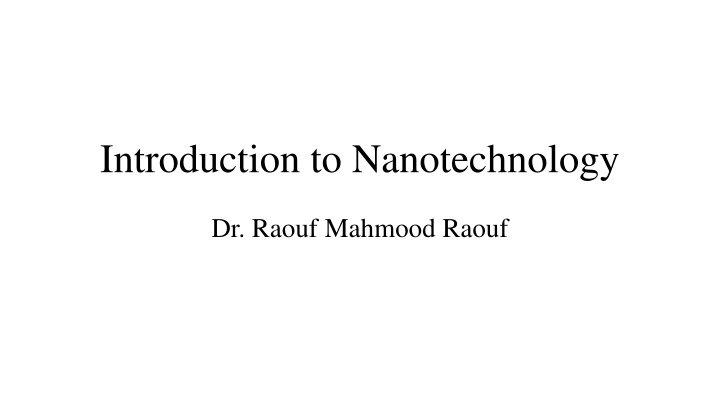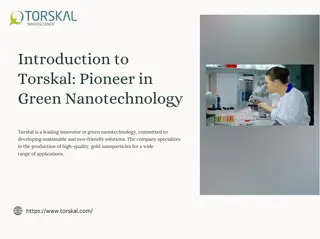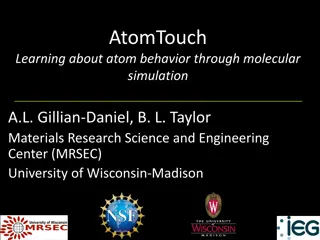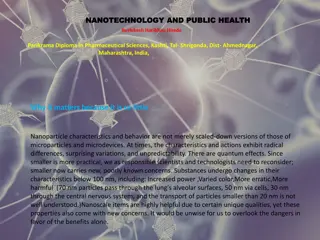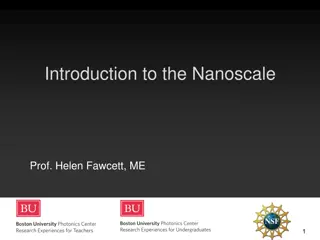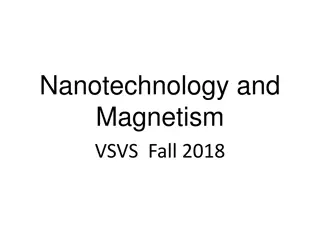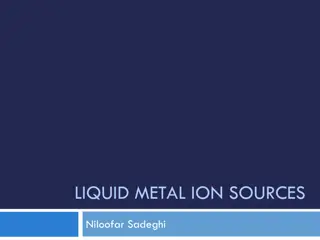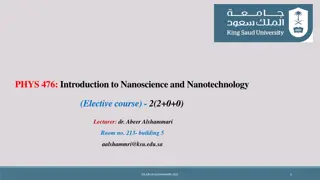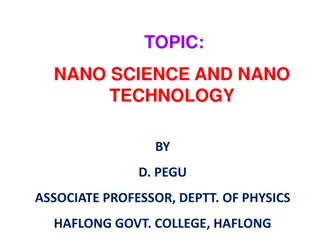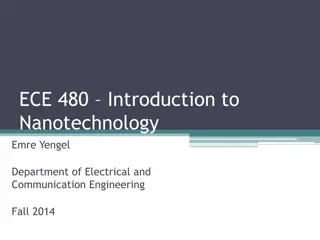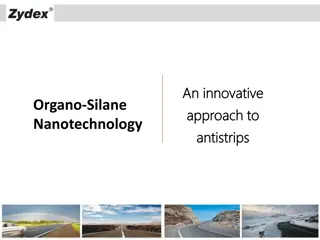Introduction to Nanotechnology
The field of nanotechnology offers a promising future with applications such as drug delivery for targeted cancer treatment, enhanced fabric properties, increased reactivity of materials, and the strength of carbon nanoparticles like nanotubes. Nanotechnology's ability to manipulate properties at a nanoscale opens up vast possibilities across various industries and scientific endeavors.
Download Presentation

Please find below an Image/Link to download the presentation.
The content on the website is provided AS IS for your information and personal use only. It may not be sold, licensed, or shared on other websites without obtaining consent from the author.If you encounter any issues during the download, it is possible that the publisher has removed the file from their server.
You are allowed to download the files provided on this website for personal or commercial use, subject to the condition that they are used lawfully. All files are the property of their respective owners.
The content on the website is provided AS IS for your information and personal use only. It may not be sold, licensed, or shared on other websites without obtaining consent from the author.
E N D
Presentation Transcript
Introduction to Nanotechnology Dr. Raouf Mahmood Raouf 1
Current and Future Trends, Research and Applications The ability to see Nano-sized materials has opened up a world of possibilities in a variety of industries and scientific endeavours. Because nanotechnology is essentially a set of techniques that allow manipulation of properties at a very small scale, it can have many applications, such as the ones listed below. 1.Drug delivery. Today, most harmful side effects of treatments such as chemotherapy are a result of drug delivery methods that don't pinpoint their intended target cells accurately. Researchers at Harvard and MIT (Massachusetts Institute) have been able to attach special RNA strands, measuring about 10 nm in diameter, to nanoparticles and fill the nanoparticles with a chemotherapy drug. These RNA strands are attracted to cancer cells. When the nanoparticle encounters a cancer cell it adheres to it and releases the drug into the cancer cell. This directed method of drug delivery has great potential for treating cancer patients while producing less side harmful effects than those produced by conventional chemotherapy. 2
Current and Future Trends, Research and Applications 2.Fabrics. The properties of familiar materials are being changed by manufacturers who are adding Nano-sized components to conventional materials to improve performance. For example, some clothing manufacturers are making water and stain repellent clothing using Nano-sized whiskers in the fabric that cause water to bead up on the surface. Reactivity of Materials. The properties of many conventional materials change when formed as nano-sized particles (nanoparticles). This is generally because nanoparticles have a greater surface area per weight than larger particles; they are therefore more reactive to some other molecules. For example studies have shown that nanoparticles of iron can be effective in the clean-up of chemicals in groundwater because they react more efficiently to those chemicals than larger iron particles. 3
Current and Future Trends, Research and Applications 20 For a fixed total volume, the radius by a factor of two doubles the surface decreasing Crushing particle particles increases the surface thousands of times! a 1cm nano into area 4
Current and Future Trends, Research and Applications 21 1 nm particles 1010 m2 1 micron particles 107 m2 1 cm particles 103 m2 nano 5
Current and Future Trends, Research and Applications Strength of Materials. Nano-sized particles of carbon, (for example nanotubes and bucky balls) are extremely strong. Nanotubes and bucky balls are composed of only carbon and their strength comes from special characteristics of the bonds between carbon atoms. One proposed application that illustrates the strength of Nano sized particles of carbon is the manufacture of t-shirt weight bullet proof vests made out of carbon nanotubes. 6
Current and Future Trends, Research and Applications 3.Micro/Nano Electro-Mechanical Systems. The ability to create gears, mirrors, sensor elements, as well as electronic circuitry in silicon surfaces allows the manufacture of miniature sensors such as those used to activate the airbags in your car. This technique is called MEMS (Micro-Electro Mechanical Systems). The MEMS technique results in close integration of the mechanical mechanism with the necessary electronic circuit on a single silicon chip, similar to the method used to produce computer chips. Using MEMS to produce a device reduces both the cost and size of the product, compared to similar devices made with conventional methods. MEMS is a stepping stone to NEMS or Nano-ElectroMechanical Systems. NEMS products are being made by a few companies, and will take over as the standard once manufacturers make the investment in the equipment needed to produce nano-sized features. 7
Current and Future Trends, Research and Applications 4.Molecular Manufacturing(MM)means the ability to build devices, machines, and finally whole products with every atom in its specified place. Today the theories for using mechanical chemistry to directly fabricate Nano scale structures are well-developed and waiting progress in enabling technologies. Assuming all this theory works and no one has established a problem with it yet exponential general-purpose molecular manufacturing appears to be inevitable. MM can be built into a self-contained, personal factory (PN) that makes cheap products efficiently at molecular scale. The time from the first fabricator to a flood of powerful and complex products may be less than a year. The potential Unfortunately, the risks are also immense.Researchers believe that raw materials can be used to reproduce almost any non-living object using this method. benefits of such a technology are huge. 8
Current and Future Trends, Research and Applications The goal of molecular manufacturing (MM) is to build complex products with almost every atom in its proper place. This requires creating large molecular shapes and then assembling them into products. The molecules must be built by some form of chemistry. Many MM proposals assume that building shapes of the required variety and complexity will require robotic placement (covalent bonding) of small chemical pieces. Once the molecular shapes are made, they must be combined to form structures and machines. Again, this is probably done most easily by robotic assembly. Theoretical studies have shown that it should be possible to build diamond lattice by mechanically guided chemistry, or mechanochemistry. By building the lattice in various directions, a wide variety of parts can be made parts that would be familiar to a mechanical engineer, such as levers and housings. A robotic system used to build the molecular parts could also be used to assemble the parts into a machine. In fact, there is no reason why a robotic system can't build a copy of itself. In sharp contrast to conventional manufacturing, only a few (chemical) processes are needed to make any required shape. And with each atom in the right place, each manufactured part will be precisely the right size so robotic assembly plans will be easy to program. A small nano-robotic device that can use supplied chemicals to manufacture nanoscale products under external control is called a fabricator. 9
Nanotechnology Language Home work Define Nanoscale Nano bio Nanodots Nanowires Nanoelectronics Nanobots Nano materials 10 6
Scale of ThingsNanometers Figure 1.5: National Nanotechnology Initiative. 11 8
References American Ceramic Society (2006, March). Overview of Safety, Risks. American Ceramic Society Bulletin. Vol. 85 Issue 3. Booker, Richard & Boysen, Earl (2005). Nanotechnology for Dummies. NJ: Wiley Publishing Inc. Diott, D.D. (2006, April). Thinking big (and small) about energetic materials. Material Science and Technology. Vol. 22 Issue 4. p. 463. Drexler, K. Eric (1986). Engines of Creation: The Coming Era of Nanotechnology. New York: Anchor Books. Henderson, Donald (2006). Bioterrorism: Interview with Donald Henderson. Asia Pacific Biotech News. Vol. 10, Issue 1, p.18. Lane, Neal & Kalil, Thomas (2005). The National Nanotechnology Initiative: Present at the creation. Issues in Science & Technology; Summer 2005. Vol 21, p49. Mukherjee, Priyabrata (2006, January). The use of Microorganisms for the formation of metal nanoparticles and their application. Applied Microbiology and Biotechnology. Vol. 69 Issue 5, p. 485. 12
References Murday, James F. (2005). Nanotechnology: Hype and Hope in Aerospace Applications. Advanced Materials and Processes. Vol. 163, Issue 12, P. 21. Rappaport, Tatiana Gabriela (2006). Semiconductors: Nanostructures and applications in spintronics and quantum computation. Vol. 809 issue 1, p.326. Wong, H.S. Philip (2006, March). Nanoelectronics Opportunities and Challenges. International Journal of High Speed Electronics and Systems. Vol. 16, Issue 1, p. 83, 12p. Yamaguchi, Tomohiko; Epstein, Irving; Shimomura, Masatsugu; & Kunitake, Toyoki (2005, December). Vol. 15, Issue 4, p. N, 3 p. 13
